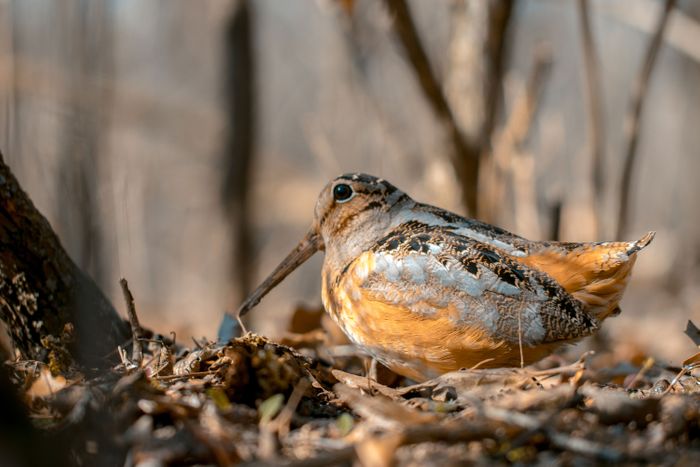
Most people refer to the four acres of green space behind the main branch of the New York Public Library as Bryant Park, but to city birders, it’s Doodletown. That’s because every year around the beginning of March, the first migratory bird to arrive in the city, the American woodcock, also known as the bogsucker, mudbat, or timberdoodle, shows up there — and to judge by bird Twitter, the species spends its layover almost exclusively there. With the woodcock’s mottled-brown egg-shaped body, long beak, and swaggering walk, few birds in New York City are stranger than this one.
Gabriel Willow, who has led NYC Audubon’s migratory-bird walks through Bryant Park for over a decade, said hearing the bird’s call — which sounds like Beaker the Muppet’s meep — as a kid in rural Maine is what first got him into birding. “But I’ve had better looks at woodcocks in Bryant Park than anywhere else,” he said, as many as four or five at a time. It’s not just Willow: On eBird, the Cornell Lab of Ornithology’s birding app, 1,121 woodcock sightings are recorded citywide, and 586 of those are in Bryant Park. Why do these odd little creatures always end up in this relatively small park?
Those numbers are somewhat self-reinforcing. Birders know they can see woodcocks in Bryant Park; therefore, more birders see woodcocks in Bryant Park. But the likely reason Doodletown is located here, in particular, is rather brutal. Bryant Park “is an oasis in the middle of a desert of tall, brightly lit buildings. For a woodcock migrating through, and probably bewildered, it offers the only safe-ish place to forage,” according to Catherine Quayle of the Wild Bird Fund. “They may also get trapped in that area by the surrounding tall buildings. Many others wind up disoriented or concussed all over midtown.” At the height of migration season — mid-March in the spring and early October in the fall — the Fund can receive upwards of 50 injured woodcocks a day. The organization’s map of woodcock building collisions shows this pattern rather starkly; there’s a cluster around lower Manhattan, then a thick band across midtown.
Getting disoriented among midtown’s skyscrapers may happen for all birds, but for the woodcock, it’s a matter of physiology: It quite literally cannot see ahead of itself. The woodcock’s eyes, set very high and far back, allow it to see both above and behind its head. But what’s great for spotting predators while dancing around and looking for worms leaves the bird effectively blind to whatever its beak is pointing toward. Many birds have a hard time seeing glassy buildings in flight, but woodcocks can’t see any building in front of them.
There are other possible explanations for Bryant Park’s status as a woodcock magnet. There may be Doodletowns in Prospect Park and Central Park, too, but with more space and more cover in these sprawling green spaces, the always well-camouflaged woodcocks may go largely unnoticed. The Bryant Park nickname? It could be the Celebrity Bird effect. “But whether it’s that they’re disoriented and Bryant Park is the closest place to land, or they’re actually seeking it out, it’s a good place for them,” Willow said.





